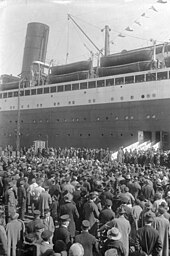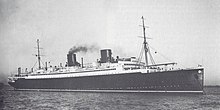Columbus (ship, 1924)
|
The Columbus around 1926
|
||||||||||||||||||||
|
||||||||||||||||||||
|
||||||||||||||||||||
|
||||||||||||||||||||
|
||||||||||||||||||||
|
||||||||||||||||||||
|
||||||||||||||||||||
The Columbus was a ship of the North German Lloyd .
history
prehistory
Before the First World War , the North German Lloyd (NDL) had two large transatlantic liners laid on the keel at the Danzig shipyard ( Schichau-Werke ), which were to be named Columbus and Hindenburg . The two were not finished by the end of the war in 1918. The Versailles Treaty made Danzig a sovereign state (" Free City of Danzig "). The shipyard and the NDL delayed the completion until the 'Columbus Agreement' of August 5, 1921 had been concluded between the British government and a German delegation that negotiated on behalf of the German government at the time. Among other things, it stipulated that the Columbus had to be ceded to Great Britain . She was renamed Homeric and drove for the White Star Line . The story of the second ship was fundamentally different.
The Hindenburg was completed for the NDL. Construction was slow due to the scarcity of materials. Instead of the originally intended name Hindenburg, the finished ship was given the name Columbus intended for the retired ship . This decision was made because of the anti-German mood prevailing at the time.
Construction and equipment
The ship was to be launched on June 17, 1922 at the Schichau shipyard in Danzig . However, it got stuck on the runway and it wasn't until August 12, 1922 that the hull was brought into the water. The ship was finished in November 1923 and left Bremerhaven on April 22, 1924 on its maiden voyage to New York .
During this time, under the direction of Hans Behrendt, several recordings were made for the feature film Neuland or Das Glückhaft Schiff with the parts Das Glückhaft Schiff "Santa Maria" and Columbus u. a. with Otto Fee in the role of the historical Christopher Columbus . The meeting of the (replica) Santa Maria and the new steamer Columbus at sea is spectacular .
The Columbus had essentially been completed in the same way as the sister ship Homeric , but the superstructure was not as piled up as the Homeric . It originally had two relatively slim tall chimneys and looked very elegant with its straight bow and sleek stern . The hull was traversed by five continuous decks and divided by 14 bulkheads . There were three holds in the front, two in the back, and the same number of hatches. The passenger accommodations were of the high standard known on German ships and were divided into three classes. This included the usual common rooms such as the dining room, smoking room, library, veranda, sports hall, etc. The large reception hall was particularly impressive.
Companions
The Columbus was the largest post-war building in Germany at the time. The Columbus' companions were the Munich and Stuttgart , which, however, were much smaller and only ran 15 knots. In addition, North German Lloyd still had the old Princess Irene , now Bremen . In 1925 the newly built Berlin was added to the North Atlantic ships. They were all so successful that real high-speed steamers began to be built. These were called Bremen and Europe .
Ship history up to the Second World War

On August 2, 1927, the Columbus's starboard propeller shaft broke in the middle of the Atlantic . The steam engine blew due to the lack of resistance and was so damaged that it was not worth repairing. As an interim solution, a small triple expansion steam engine from the freight steamer Schwaben was installed at the Vulkan shipyard in Bremen , so that it could initially continue its North Atlantic service at reduced speed. In 1929, two new geared turbine sets with a total output of a maximum of 49,000 shaft horsepower were installed in Hamburg , which increased the speed to up to 23 knots and the Columbus could be used in the now introduced North Atlantic express service of the NDL.
During the stay in the shipyard, the passenger accommodations were also refurbished and the slender chimneys were replaced by thicker ones. The appearance thus approached that of Bremen and Europe . Ultimately, she was not as fast as the other two ships, but with her speed of 22-23 kn , she was one of the classy express steamers. As such, the Columbus sailed until the outbreak of World War II and also made a name for itself as a cruise ship . For example, one of these trips lasted 47 days and went around South America .
The end of the ship
Shortly before the start of the Second World War, the ship was on a cruise in the Caribbean . It received an order from Germany to immediately call at a neutral port outside the USA . However, it was only after several unsuccessful attempts at various ports that the predominantly American passengers were able to be brought ashore in Havana ( Cuba ). Then the ship reached the port of Veracruz in Mexico with the last fuel reserves . On December 14, 1939, it set sail again, refueled by a German ship, in order to make the breakthrough to Germany. The proposal of the captain Wilhelm Dähne to the owner to sell the ship in Mexico and to buy it again after the end of the war was rejected. It initially moved north through the neutral waters of Mexico and the United States to avoid British warships. In US waters, the ship was accompanied by alternate American destroyers , which were later replaced by the US cruiser Tuscaloosa . Every hour, he sent unencrypted his own position and the fact that they were accompanying the Columbus . The ship was discovered on December 19, 1939, shortly after it had left US-controlled waters, by the British destroyer Hyperion , who wanted to arrest it. The destroyer fired two warning shots across the bow of the Columbus . However, the crew did not want to let the valuable ship fall into the hands of the British. She set the ship on fire, opened the sea valves and disembarked. Three stokers did not make it into the boats in time and died on board. The Columbus sank in the Atlantic, 320 nautical miles east of Cape Hatteras .
The whereabouts of the team after the sinking
The crew was picked up by the Tuscaloosa and taken to New York. The United States of America was still a neutral country at that time, which is why the German seafarers came to the USA as shipwrecked . Boarding the Hyperion would have meant internment in Britain.
The crew, including the captain, could have asked for admission to the USA under maritime law as castaways, but stated on Ellis Island that they wanted to return to Germany. As a result, 567 male and nine female crew members were interned in the USA, initially in California (on Angel Island ), later in New Mexico (Fort Stanton) and South Dakota . Most of them did not return to Bremen until after the end of the war in 1945. Some stayed in America.
Liner services
- Bremerhaven – New York
Movies
- The last voyage of the Columbus , film by Reinhard Joksch and Annette Sander, Radio Bremen, 2008: The film documents the time from summer until the on- board photographer Richard Fleischhut (also 16 mm films) and the log book December 1939 and follows the fate of the crew after the sinking of the ship through interviews with seafarers who are still alive.
literature
- Gottlob Mayer: Columbus: The largest ship in the German merchant fleet . With 17 illus. In: Reclams Universum: Moderne illustrated Wochenschrift 40.1 (1924), pp. 333–338.
- Arnold Kludas : The ships of the North German Lloyd, 1857 to 1970 . Weltbild, Augsburg 1998, ISBN 3-86047-262-3 .
- Peter Dittrich: "Cruise" by the Lower Saxony gymnast. "Gauturnfahrt" with the Lloyd steamer Columbus 80 years ago . In: Men from Morgenstern , Heimatbund an Elbe and Weser estuary e. V. (Ed.): Niederdeutsches Heimatblatt . No. 788 . Nordsee-Zeitung GmbH, Bremerhaven August 2015, p. 1–2 ( digital copy [PDF; 2.2 MB ; accessed on August 4, 2020]).
Web links
Footnotes
- ↑ Wording of the contract.
- ↑ End of a luxury liner . ( Page no longer available , search in web archives ) Info: The link was automatically marked as defective. Please check the link according to the instructions and then remove this notice. In: Friday , December 12, 2009.




